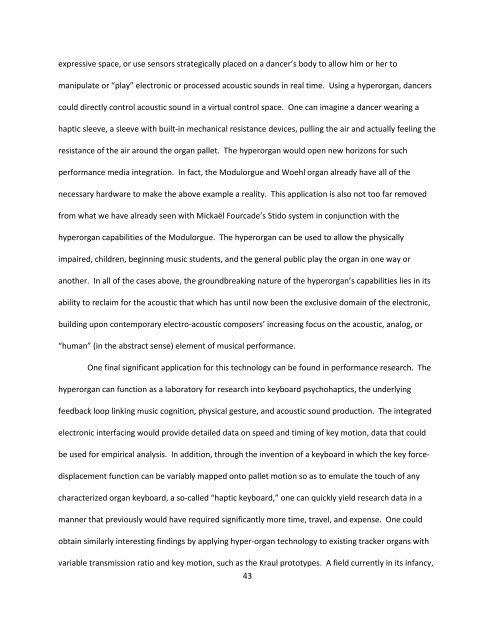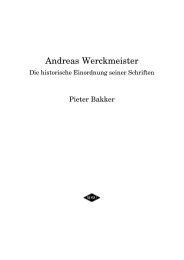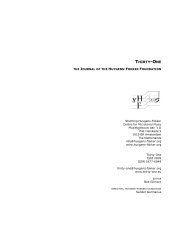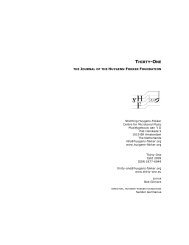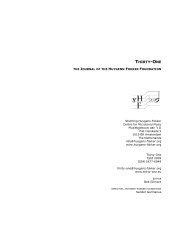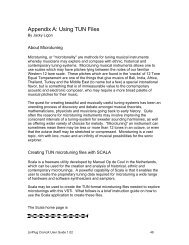Recent Organ Design Innovations and the 21st-century - Stichting ...
Recent Organ Design Innovations and the 21st-century - Stichting ...
Recent Organ Design Innovations and the 21st-century - Stichting ...
Create successful ePaper yourself
Turn your PDF publications into a flip-book with our unique Google optimized e-Paper software.
expressive space, or use sensors strategically placed on a dancer’s body to allow him or her to<br />
manipulate or “play” electronic or processed acoustic sounds in real time. Using a hyperorgan, dancers<br />
could directly control acoustic sound in a virtual control space. One can imagine a dancer wearing a<br />
haptic sleeve, a sleeve with built-in mechanical resistance devices, pulling <strong>the</strong> air <strong>and</strong> actually feeling <strong>the</strong><br />
resistance of <strong>the</strong> air around <strong>the</strong> organ pallet. The hyperorgan would open new horizons for such<br />
performance media integration. In fact, <strong>the</strong> Modulorgue <strong>and</strong> Woehl organ already have all of <strong>the</strong><br />
necessary hardware to make <strong>the</strong> above example a reality. This application is also not too far removed<br />
from what we have already seen with Mickaël Fourcade’s Stido system in conjunction with <strong>the</strong><br />
hyperorgan capabilities of <strong>the</strong> Modulorgue. The hyperorgan can be used to allow <strong>the</strong> physically<br />
impaired, children, beginning music students, <strong>and</strong> <strong>the</strong> general public play <strong>the</strong> organ in one way or<br />
ano<strong>the</strong>r. In all of <strong>the</strong> cases above, <strong>the</strong> groundbreaking nature of <strong>the</strong> hyperorgan’s capabilities lies in its<br />
ability to reclaim for <strong>the</strong> acoustic that which has until now been <strong>the</strong> exclusive domain of <strong>the</strong> electronic,<br />
building upon contemporary electro-acoustic composers’ increasing focus on <strong>the</strong> acoustic, analog, or<br />
“human” (in <strong>the</strong> abstract sense) element of musical performance.<br />
One final significant application for this technology can be found in performance research. The<br />
hyperorgan can function as a laboratory for research into keyboard psychohaptics, <strong>the</strong> underlying<br />
feedback loop linking music cognition, physical gesture, <strong>and</strong> acoustic sound production. The integrated<br />
electronic interfacing would provide detailed data on speed <strong>and</strong> timing of key motion, data that could<br />
be used for empirical analysis. In addition, through <strong>the</strong> invention of a keyboard in which <strong>the</strong> key force-<br />
displacement function can be variably mapped onto pallet motion so as to emulate <strong>the</strong> touch of any<br />
characterized organ keyboard, a so-called “haptic keyboard,” one can quickly yield research data in a<br />
manner that previously would have required significantly more time, travel, <strong>and</strong> expense. One could<br />
obtain similarly interesting findings by applying hyper-organ technology to existing tracker organs with<br />
variable transmission ratio <strong>and</strong> key motion, such as <strong>the</strong> Kraul prototypes. A field currently in its infancy,<br />
43


